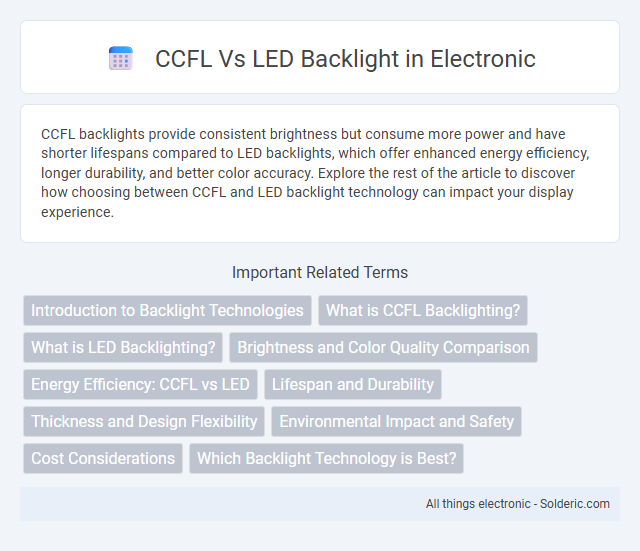CCFL backlights provide consistent brightness but consume more power and have shorter lifespans compared to LED backlights, which offer enhanced energy efficiency, longer durability, and better color accuracy. Explore the rest of the article to discover how choosing between CCFL and LED backlight technology can impact your display experience.
Comparison Table
| Feature | CCFL Backlight | LED Backlight |
|---|---|---|
| Light Source | Cold Cathode Fluorescent Lamp | Light Emitting Diode |
| Brightness | Moderate | High |
| Energy Efficiency | Lower (higher power consumption) | Higher (energy-saving) |
| Color Accuracy | Good | Excellent |
| Thickness of Display | Thicker | Thinner, slim design |
| Lifespan | Shorter (around 20,000 hours) | Longer (up to 50,000 hours) |
| Heat Emission | Higher | Lower |
| Cost | Usually lower initial cost | Higher initial cost but lower operation cost |
| Environmental Impact | Contains mercury, harder to dispose | Mercury-free, eco-friendly |
Introduction to Backlight Technologies
CCFL and LED backlights serve as key technologies in display screens, each providing distinct illumination methods. CCFL (Cold Cathode Fluorescent Lamp) utilizes fluorescent tubes to light up LCD panels, offering consistent brightness and color accuracy. LED backlights, employing light-emitting diodes, deliver higher energy efficiency, thinner displays, and enhanced contrast ratios, giving your screen sharper visuals and longer lifespan.
What is CCFL Backlighting?
CCFL backlighting uses cold cathode fluorescent lamps to illuminate LCD screens, providing bright and even light distribution essential for display visibility. These lamps require a high voltage to operate and are known for producing consistent white light but consume more power compared to LED backlights. Understanding your device's backlighting technology can help optimize energy use and display performance.
What is LED Backlighting?
LED backlighting uses light-emitting diodes placed behind or along the edges of an LCD screen to illuminate the display, offering higher energy efficiency and better brightness control compared to CCFL backlights. Unlike CCFL (Cold Cathode Fluorescent Lamp) technology, LED backlights provide more vivid colors and thinner screen designs due to their compact size. Your viewing experience improves with LED backlighting through enhanced contrast ratios and longer lifespan, making it the preferred choice for modern displays.
Brightness and Color Quality Comparison
LED backlights offer superior brightness levels compared to CCFL, enabling more vivid and dynamic screen displays. Color quality in LED-backlit displays is enhanced with a wider color gamut and better color accuracy, resulting in richer and more lifelike images. Your viewing experience improves significantly with LED technology due to its ability to produce deeper blacks and higher contrast ratios.
Energy Efficiency: CCFL vs LED
LED backlights consume up to 40% less power compared to CCFL backlights, significantly enhancing energy efficiency in modern displays. CCFLs require higher voltages and generate more heat, leading to greater energy loss and shorter lifespan. Your choice of LED technology can reduce electricity costs and contribute to a more environmentally friendly device.
Lifespan and Durability
LED backlights typically offer a longer lifespan, averaging around 50,000 hours compared to CCFL's 20,000 to 30,000 hours. LEDs also provide greater durability due to their solid-state construction, making them less prone to damage from shocks or vibrations than the fragile glass tubes used in CCFLs. This extended lifespan and robustness make LED backlighting a more reliable choice for long-term display performance.
Thickness and Design Flexibility
LED backlights are significantly thinner than CCFL (Cold Cathode Fluorescent Lamp) backlights, enabling ultra-slim and lightweight display designs. LED technology offers greater design flexibility, allowing for edge-lit or full-array configurations that optimize brightness and contrast while reducing overall device thickness. In contrast, CCFL backlights require bulkier components and uniform placement, limiting the potential for sleek, compact displays.
Environmental Impact and Safety
LED backlights consume significantly less energy than CCFLs, reducing your carbon footprint and lowering greenhouse gas emissions. CCFLs contain mercury, posing environmental hazards and requiring special disposal methods to prevent soil and water contamination. LED technology also generates less heat and avoids toxic materials, enhancing safety during manufacturing and use.
Cost Considerations
CCFL backlights generally have a lower initial manufacturing cost but consume more power, leading to higher electricity expenses over time compared to LED backlights. LED backlighting offers greater energy efficiency and longer lifespan, which significantly reduces operational and replacement costs. Despite a higher upfront price, LED technology provides better cost-effectiveness for long-term use in display devices.
Which Backlight Technology is Best?
LED backlight technology offers superior energy efficiency, longer lifespan, and better color accuracy compared to CCFL backlights. CCFL backlights tend to consume more power and have slower response times, making them less ideal for modern high-definition displays. LED backlights also provide thinner panels and improved brightness, positioning them as the best choice for current display technology.
CCFL vs LED Backlight Infographic

 solderic.com
solderic.com